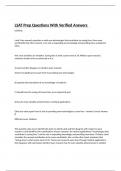Essay
Essay Unit 11 - Psychological Perspectives TASK 2
- Course
- Institution
This coursework is unit 11 psychological perspective. Its task 2 coursework for this unit. I achieved a distinction in this piece of coursework. It also has purple pen improvements and references are included at the bottom. All criteria is met.
[Show more]












